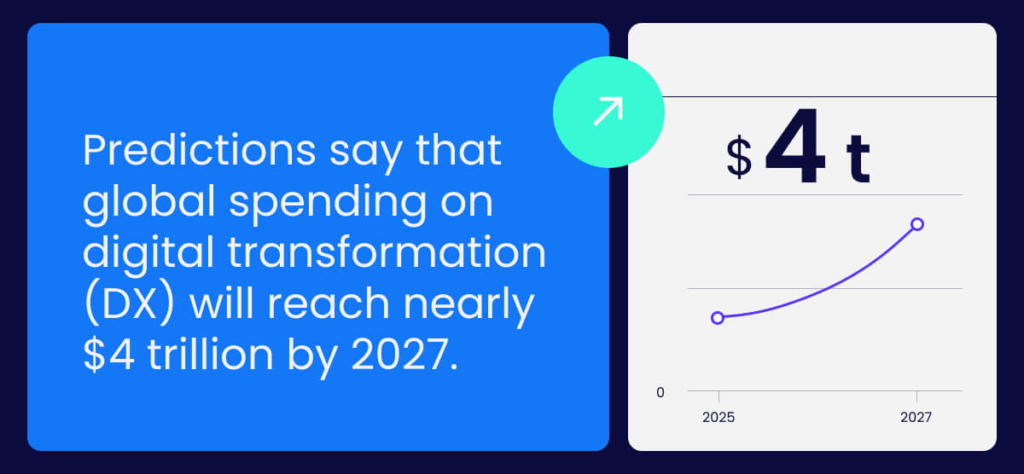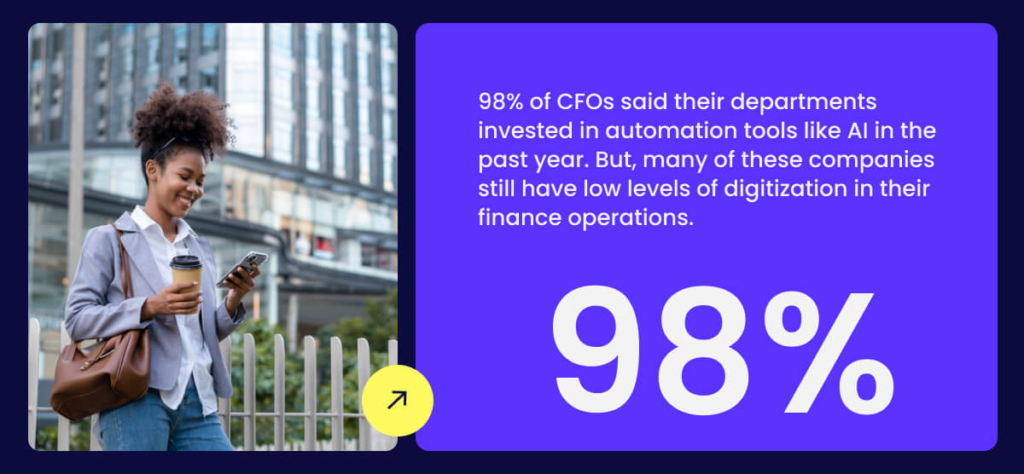Digital transformation is a company-wide strategy to use digital technology to improve business processes and create new services. It helps organizations better employee engagement, support customer care, improve operations, and increase profits.
Data from Statista shows that 75% of companies are likely to adopt AI, cloud computing, and data analytics technology from 2023 to 2027. In other words, companies that don’t may struggle to compete or survive. This means that digital transformation still matters to you.
This article will share 39 of the most important digital transformation statistics you need to know for 2025. This way, we will highlight why it is essential for ongoing growth and success.
Global and country-specific digital transformation statistics
In this first section, we will explore global and country-specific digital transformation trends. So, let’s explore global and country-specific spending and usage statistics.

Global spending and usage trends
- Predictions say that global spending on digital transformation (DX) will reach nearly $4 trillion by 2027. DX spending could make up over two-thirds of all Information and Communication Technology (ICT) costs by 2027. (IDC).
- The global digital transformation market will grow fast. You can expect a yearly growth rate of 23.6% from 2022 to 2030 (Polaris Market Research).
- Global IT spending is set to grow 9% in 2025. This is up from about 8% in 2024, driven by rising AI-related data center costs and renewed spending on traditional hardware (S&P Global).
- Digital transformation includes using artificial intelligence (AI), automating processes, and storing data in the cloud. In a global survey, 77% of individuals said AI will impact their work in the next five years (Thomas Reuters).
- Companies with strong digital and AI skills earn two to six times higher shareholder returns than those that fall behind in every sector studied (McKinsey).
- Expanding digital access is expected to be the biggest change for businesses. 60% of employers saying it will impact their operations by 2030. Other major changes include growth in AI and data processing (86%), robotics and automation (58%), and energy technology (41%). These trends will affect jobs in different ways. It will create new roles while making others disappear (World Economic Forum).
- In a global survey of consumer goods leaders, 71% said they use AI in at least one part of their business. 56% said they regularly use generative AI (McKinsey).
- A study showed that 50% of companies have added AI and IoT to their systems. 33% plan to adopt these technologies in the next two years (Kapersky).
- Currently, 23% of employees use AI/ML to automate repetitive tasks. Another 60% are open to using it in the future (EY).
- The spatial computing industry will transform healthcare, manufacturing, logistics, and entertainment. This industry includes AR, VR, and the Internet of Things. You can expect it to grow by 18.2% each year from 2022 to 2033 (Deloitte).
Country-specific spending and usage trends
- Latin America and China are the fastest-growing regions for digital transformation spending. They have five-year growth rates of 17.9% and 17.4% (IDC).
- Singapore ranked first in an emerging technology study. It looked at a world digital competitiveness rating among 67 countries. This country was followed by Switzerland in second place and Denmark in the third (IMD).
- European companies are 45% to 70% behind U.S. companies using generative AI. For example, Europe trails the U.S. in computing power. Europe has 18% of the world’s data center capacity. But the U.S. has 37%, even though their GDPs are similar, at about $23 trillion and $27 trillion (McKinsey).
- In Asia, 45% of companies have adopted generative AI, a bit higher than in other regions. Only 16% of companies in Asia have little or no GenAI adoption. You can compare this to 18% in North America and 23% in Europe (Boston Consulting Group).
Sector-specific digital transformation insights
Here’s how digital transformation will affect different sectors in 2025.
Manufacturing
- 80% of manufacturers are using tools to optimize their supply chains. But, many companies struggle to connect their vision with everyday operations. Instead, they focus more on solving individual problems. Progress is slower in the later stages of manufacturing. Only 41% using IoT for advanced sensing and tracking of inventory and warehouses (Manufacturers Alliance).
- If manufacturing companies don’t adopt technologies like AI and robotics, they miss out on 30% to 50% of potential productivity (Bain & Company).
- 92% of manufacturers say digital transformation is a top priority. But, only 16% have real-time monitoring of the entire manufacturing process. Without technology, it’s hard to track the status of equipment, raw materials, and workers during production (Zebra).
- 44% of manufacturers say the data they collect has doubled in the past two years and expect it to triple by 2030. But, most have moderate confidence in their data analysis ability (National Association of Manufacturers).
- 55% of industrial product manufacturers already use generative AI tools in their operations, and more than 40% plan to invest more in AI and machine learning over the next three years (Deloitte).
Healthcare
- In 2024, the global digital health market earned about 172 billion U.S. dollars. You can expect to grow to 258 billion U.S. dollars by 2029 (Statista).
- Big data is important in healthcare as it helps with preventive care. It also leads to better patient outcomes, and improved efficiency. But, less than 5% of health data is currently used to improve health outcomes. (World Bank).
- 75% of people surveyed said their organizations prioritize digital and analytics transformation. But, they also said that their companies lack enough resources or planning for it (McKinsey).
- 60% of respondents believe digital tools can improve communication with care teams. 55% think they can increase access to care. 40% believe they can help lower out-of-pocket costs (Deloitte).
Financial services
- Denmark leads with 97.76% of its people using online banking. Norway follows at 96.8%, and the Netherlands is third at 96.35%. These numbers show Northern Europe’s strong use of digital financial services (Statista).
- 46% of financial services leaders say digital transformation has boosted employee productivity. Additionally, 45% saw bigger improvements in employee satisfaction. This gives them an edge in attracting and keeping talent in the industry (KPMG).
- AI could boost global banking profits to $2 trillion by 2028, a 9% rise over the next five years (CitiGroup).
- Over 75% of banks plan to invest more in data management and cloud services. This will be to support their generative AI strategies (Deloitte).
- 98% of CFOs said their departments invested in automation tools like AI in the past year. But, many of these companies still have low levels of digitization in their finance operations (McKinsey).

Retail
- 71% of consumers want companies to understand their preferences. This shows that personalization is not only for luxury brands. The focus is now on guiding and inspiring customers across different channels (Think With Google).
- Consumers said only 43% of their experiences felt personalized. This is even though brands claim they personalize 61% of experiences. This shows a gap between what brands aim for and what customers feel. This means many brands aren’t meeting consumer expectations for personalization (Deloitte).
- AI services in retail will grow from $5 billion to over $31 billion by 2028 (World Economic Forum).
- A survey of 20,000 consumers found that over half want to use chatbots or virtual assistants (55%) while shopping. This is the same for augmented or virtual reality (55%) and AI tools (59%) (IBM).
Digital transformation adoption rates and outcomes
In this section, we’ll look at digital transformation’s adoption rates and benefits experienced.
Adoption rates across businesses and industries
- In the U.S., large firms with 250 or more employees had the highest digital adoption rate at 7.2%. Small firms with 1 to 4 employees followed at 5.5%. Medium-sized firms with 5 to 249 employees had lower adoption rates (Census Bureau).
- Digital adoption in the U.S. differs by industry. The Information sector leads with 18% using AI. Next are professional, scientific, and technical services at 12%. In contrast, agriculture and construction have low AI use at 1% (North Carolina Department of Commerce).
- In the EU, 59% of all businesses have a basic level of digital use. For small and medium-sized businesses (SMEs), it’s 58%, 30% below the EU’s 2030 goal. Large businesses are much higher at 91% (Eurostat).
- 95% of European companies have reduced IT costs and improved productivity through the cloud. But, 82% say these adoption benefits are only across non-IT parts of the business (McKinsey).
Business outcomes and drivers
- 41% of companies have seen better customer experiences with GenAI. Additionally, 40% have gained higher productivity (PwC).
- 87% of organizations have used technology to boost profits in the past 24 months. Among them, 59% saw profits grow by at least 11% from digital transformation. (KPMG).
- Companies that align digital change with their strategy and tech investments have a 14% higher market value than those that don’t. For Fortune 500 firms, this could mean a $2.75 trillion advantage. This shows the massive value at risk (Deloitte).
Accelerate your digital transformation journey in 2025 with these insights
Digital transformation is essential for businesses to remain agile. These statistics show that more companies are investing in technology and changing their strategies. These efforts help businesses grow, cut costs, and work better.
Building skills in AI, data analytics, and cybersecurity is also critical. Digital transformation will continue to drive business success. But it takes time, effort, and resources to fully integrate into daily operations. Companies must also shift their mindset and culture to succeed.
Starting small with key projects allows businesses to test and learn before expanding. Choosing the right digital tools is important for meeting goals. Training employees helps them use new technologies well. Managing the change management process with support and training reduces resistance. Tracking progress and making changes ensures better results over time.
FAQs
Studies from McKinsey show that only 30% of digital transformations fully succeed. Most companies struggle to meet all their goals. Success is likely when companies align strategy, invest in the right technology, and manage change well.
Research from BCG states that 70% of digital transformations fail due to a lack of employee engagement and resistance during the implementation process.

